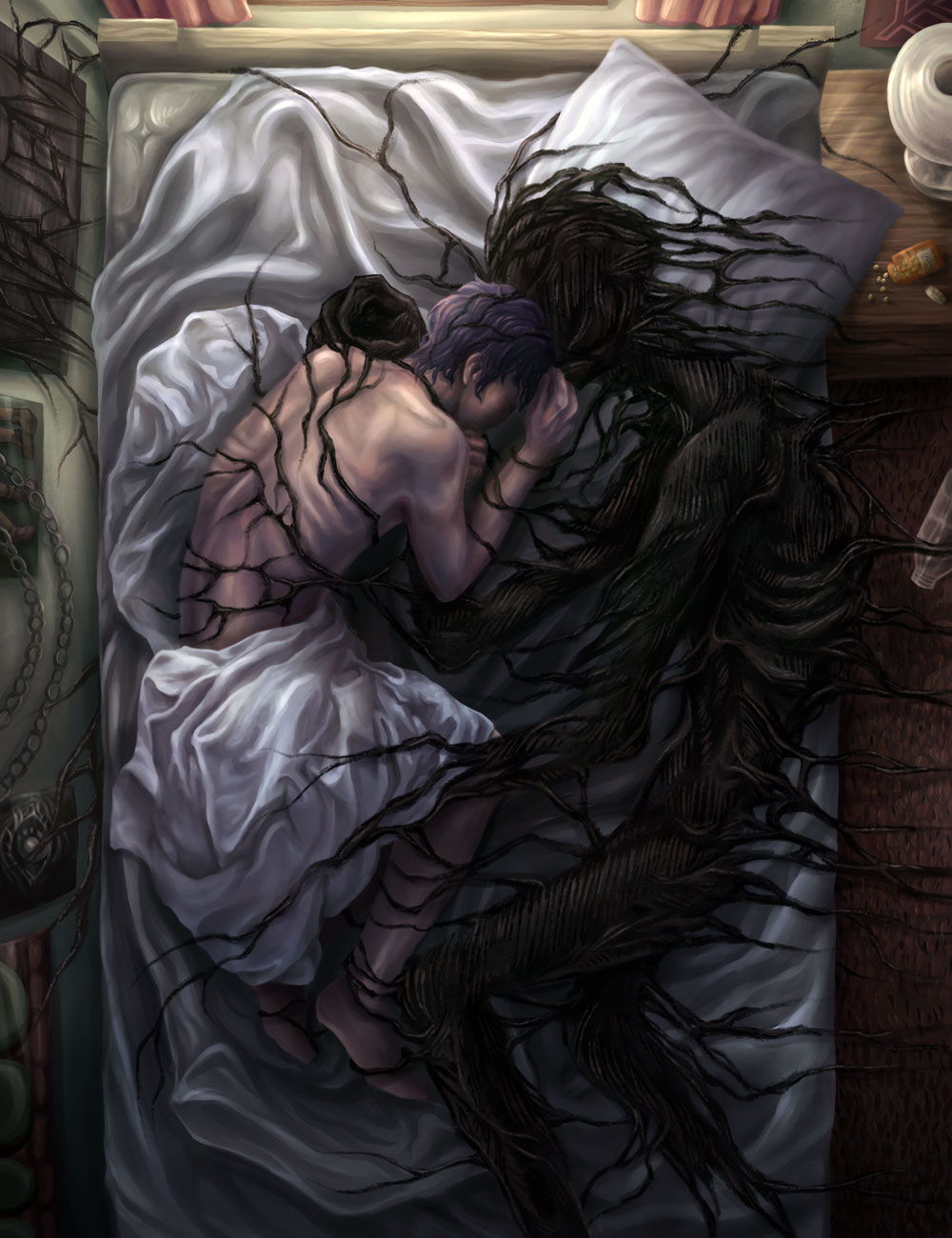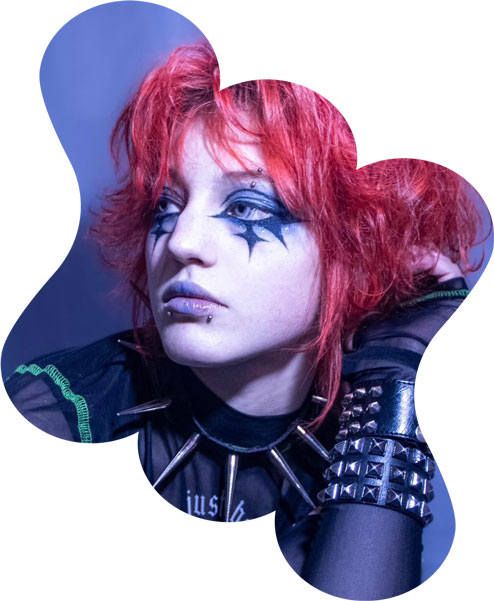

Descent

Height: 27" x Width: 21" | Material(s): Apple Pencil and iPad on Procreate program | Process(es): Creature drawn with Damp Brush, rest with smooth brushes. Multiply & add layers for light source. | Idea(s): The struggle of getting out of bed from the perspective of individuals with depressive disorders. | Curatorial Note: A heartbreaking yet exquisite and intimate representation of the struggles of mental health. The powerful image pulls you in with its contrasting light and dark and sinewy lines and drapery, seemingly echoing the complicated nature of the struggle.
Heidi Gully
What did you do to improve your 2-D, 3-D, or Drawing portfolio skills?
To improve my skills, I did a lot of practice sketching, was open to commissions, experimented with different mediums and art styles, and learned from constructive criticism.
Describe the critique practices and feedback you received in AP Art and Design.
I was given critiques considering the composition of certain pieces, as well as the use of contrast. It was also suggested that I attempt to diverge from my typical color palette, but it was not something required.
In what ways did your art-making confidence increase in AP Art and Design?
I was given much more freedom going into AP Art when creating my sustained investigation. I could explore any theme I was interested in, which mediums to use, and how to go about the project in general. I was able to develop my style throughout the year as well and could connect with the other art students. I had a lot of supporters who would encourage me to keep creating as well.
How did you modify or revise your art-making direction based on feedback?
I was allowed to return to finished pieces and work on improving the aspects of that work that were criticized. In my case, I would increase or decrease contrast and lighting or change minor parts of a composition.
Can I demonstrate an in-depth exploration of how my personal experiences with mental illness have affected my daily life and my perception of the world and myself? To convey this idea, I used surrealistic visuals and symbolism.
How did your classmates help you in the creative process?
We had designated critique days, and they were very insightful and helpful in receiving an outside perspective. Suggestions could be made, or a classmate could note the parts they admire about someone's art. It was also an encouraging space to be in while working.
Did you participate in art shows at your school or in your community?
My entire sustained investigation was created digitally, so I had each piece printed individually on good-quality paper and mounted them on the wall. I grouped half of my pieces in one area on the first floor, and the other half in its own space on the second floor. The feedback I received was very positive. Family, friends, and peers visited, and some bought prints. I was told this particular work, Descent, had powerful emotional imagery and created discussions about the subject matter between those who viewed it.
Do you show your work through social media? If so, did you use feedback from social media account(s) to help you make decisions about your artwork?
Yes, I display some of my artwork on my Instagram account. I find I don't get much constructive criticism from viewers, mainly just compliments. I post whatever I want, and I'm not very motivated by what is trending or what the algorithm requires for maximum interaction.
Christine Teplitsky
Art Teacher
Strathcona High School, Edmonton, Alberta, Canada
Teacher statement
Teacher statement
How did you support skill development AND inquiry in the AP Art and Design curriculum?
In the AP Art and Design curriculum, I supported skill development and inquiry by encouraging students to refine both their technical and media skills through hands-on practice and personalized feedback. I provided clear examples and demonstrations on various artistic processes and mediums, ensuring that students had the foundational knowledge they needed to experiment and grow. Through these demonstrations, I not only showed the step-by-step processes but also discussed how to approach challenges with resilience, fostering a mindset that mistakes are opportunities for learning. I regularly conducted one-on-one critiques, providing constructive feedback that helped students refine their work and develop their unique artistic voice. By emphasizing the importance of consistent practice, I motivated students to push beyond their comfort zones and explore new techniques, encouraging them to revisit and refine their projects over time. This combination of direct instruction, feedback, and ongoing practice helped students not only build their technical abilities but also develop critical thinking and problem-solving skills in their artistic endeavors.
How do you support your students in the Selected Works portfolio component?
In supporting my students with the Selected Works portfolio component, I emphasize the importance of creating works that demonstrate a thoughtful synthesis of materials, process, and ideas. From grade 10 onward, I foster this mindset by encouraging students to approach each project with the intention of integrating these elements cohesively. By gradually building this understanding, students develop the ability to create work that not only showcases technical skill but also reflects a deep conceptual exploration. I provide ongoing feedback throughout the process, guiding students to refine their pieces and think critically about how each work contributes to their overall artistic journey. However, I also encourage students to take ownership of their portfolio selection by reflecting on which pieces they feel most proud of and consider the works that best represent their growth as artists. This process empowers students to make confident, reflective choices while ensuring that their portfolio is a true reflection of their unique creative voice and vision.
What did you learn from working with your student?
Working with my AP art student, Heidi, was an incredibly enriching experience that taught me valuable lessons about the creative process. Heidi’s work reminded me of the importance of trusting students’ intuition and allowing them to fully explore their passions and interests without constraint. They demonstrated that when students are given the freedom to follow what excites them, the work becomes not only more authentic but also more deeply meaningful. Through Heidi, I also learned that digital mediums can be just as sophisticated and beautiful as traditional ones. The depth and complexity of their digital artwork left me in awe, as they harnessed the power of modern technology to create pieces that were both visually stunning and conceptually rich. This experience reinforced for me the significance of guiding students to select a personal and meaningful inquiry for their sustained investigation, as it leads to more authentic, passionate, and ultimately beautiful art. I left this experience with a renewed appreciation for fostering creative freedom and honoring the diverse ways in which students express their artistic voices.
Scott Couprie
Curriculum Coordinator of Advanced Placement
Strathcona High School, Edmonton, Alberta, Canada
Leader Statement
Leader Statement
What are you most proud of regarding your school’s AP Art and Design program, student, and teacher?
We are extremely proud of our Visual Arts program at Strathcona High School. The vibrancy, creativity, and technical skill shown by our student artists is a testament to their efforts and those of our amazing art teacher Christine Teplitsky.
What do you do to support visual arts programming in your school?
Fine Arts is considered one of the core pillars of education at Strathcona. We are proud to show our students' work in our hallways and meeting centers. Plus, our AP Fine Art Show and Auction that takes place at our local university is one of the highlights of our year!
What is your advice to other school leaders on how to support an AP Art and Design program?
Show off your students’ work! At every opportunity, display their pieces and champion the program's successes.
Heidi Gully



